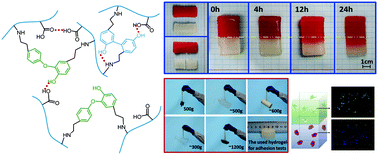A dynamic-coupling-reaction-based autonomous self-healing hydrogel with ultra-high stretching and adhesion properties†
Abstract
Hydrogels with autonomous self-healing properties and excellent mechanical and adhesion properties have wide applications in many fields. However, to achieve them is a big challenge. We explored a novel strategy to do that by using a dynamic coupling reaction of tyrosine hydrochloride. A compressive strength of 15 MPa and an elongation of over 4000%, the highest adhesion strength (to pigskin) of 453 kPa and an autonomous self-healing ratio of 99% under mild conditions were achieved for the as-obtained hydrogels. The excellent mechanical and adhesion properties and super-high self-healing properties of the as-prepared hydrogel provide a good prospect for their applications in tissue engineering, wound dressings, surgical sticky bandages, soft robotics and machinery, etc. Meanwhile, this strategy that employs this kind of coupling reaction under mild conditions to construct a hydrogel network provides a new idea for the design and preparation of autonomous self-healing materials.



 Please wait while we load your content...
Please wait while we load your content...